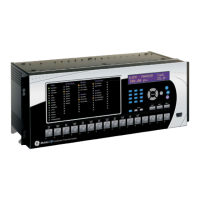5-220 T35 TRANSFORMER PROTECTION SYSTEM – INSTRUCTION MANUAL
GROUPED ELEMENTS CHAPTER 5: SETTINGS
5
since the fault voltage is not the system voltage, but rather the result of the transformation ratio between the primary
windings and the percentage of shorted turns on the secondary. Therefore, the resultant differential currents can be below
the slope threshold of the main differential element and the fault can go undetected. Application of the restricted ground
fault protection extends the coverage towards the neutral point (see the following figure).
Figure 5-113: RGF and percent differential zones of protection
This protection is often applied to transformers having impedance-grounded wye windings. The element can also be
applied to the stator winding of a generator having the neutral point grounded with a CT installed in the grounding path, or
the ground current obtained by external summation of the neutral-side stator CTs. The following figure shows the basic
application and wiring rules.
Figure 5-114: Typical applications of RGF protection
The relay incorporates low-impedance restricted ground fault protection. This low-impedance form of protection faces
potential stability problems. An external phase-to-phase fault is an ultimate case. Ideally, there is neither ground (IG) nor
neutral (IN = IA + IB + IC) current present. If one or more of the phase CTs saturate, a spurious neutral current is seen by the
relay. This is similar to a single infeed situation and can be mistaken for an internal fault. Similar difficulties occur in a
breaker-and-a-half application of the restricted ground fault, where any through fault with a weak infeed from the winding
itself can cause problems.

